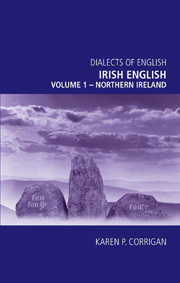3 - Morphosyntax
Published online by Cambridge University Press: 12 September 2012
Summary
Introduction
There has been much recent discussion of the extent to which features occurring in English vernaculars are either ‘global’ and thus shared across varieties or ‘local’ and therefore particularised to discrete communities of speakers (Coupland 2003; Filppula et al. 2008). Hence, there have been suggestions that postcolonial varieties of English, like those in the Celtic countries, exhibit so-called ‘Angloversal’ features of morphosyntax on account of the type of L2 acquisition process that created them (Filppula 2006; Kortmann and Szmrecsanyi 2004). Indeed, there is research which suggests that postcolonial varieties as well as other language contact types like English-based pidgins/creoles also share a set of ‘vernacular universals’ (phonological/morphosyntactic features) with child language and other English dialects that have no recent history of colonisation (Chambers 2003: 242–50). As such, Milroy and Milroy (1993: xiv) remark that ‘a clear distinction cannot always be drawn between localised non-standard constructions and those that have a wide regional distribution’. This global/local dichotomy is addressed here by devoting less space to those features of NIE/US like the levelling of verb forms/default singulars (§3.4) which are vernacular primitives in the sense of Chambers (2003: 242) than to those that appear to be more widespread socially in NIE/US and other Celtic Englishes (and indeed are restricted to them in certain respects). It should be borne in mind, however, as Harris (1984b) first noted in the context of NIE/US, that even global features can be interpreted locally.
- Type
- Chapter
- Information
- Irish English, volume 1 - Northern Ireland , pp. 51 - 78Publisher: Edinburgh University PressPrint publication year: 2010

